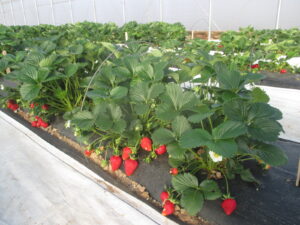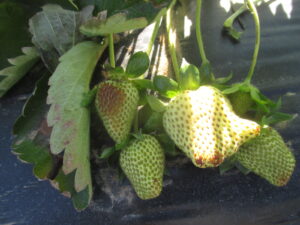Strawberries have a rich flavor; sugar, acid, phenolic content, and aroma all together make the wonderful fruit. Many factors are assumed to affect strawberry flavor. Some are supported by scientific evidence, some may be simply people’s impressions. In this article, we discuss some of the factors that are more likely to affect strawberry flavor.
Locally grown strawberries often taste better than strawberries purchased from grocery stores. Part of the reason is that strawberries shipped long distances are harvested a few days before they are fully ripe. The fruit has longer shelf-life but the flavor is sacrificed.
We are testing ten strawberry varieties in a high tunnel and in an open-field in southern Indiana this spring. Regardless of cultivars, we consistently noticed better fruit quality (higher sugar content, softer, and much cleaner) for strawberries grown inside of the high tunnel than grown in the open-field (Figure 1). I do not think it is fair to say the high tunnel itself makes the berry taste better. The conclusion would be too blank. Let’s look further to see the potential reasons.
One big difference is the management system. We used a more intensive fertility management system inside the high tunnel than in the field. In the high tunnel, plants were fertigated during all the irrigation events starting in February (from once a day to three times a day). Plants grown in the open field depended on preplant fertilizers applied in the fall until April and then fertigated once a week. Another difference is temperature. In general, the high tunnel has a greater day/night temperature difference until more recently, this is another factor known to favor sugar accumulation. Strawberries grown in the open-field have been exposed to strong wind several times at the fruit forming stage. Many immature fruit are injured by sand (Figure 2). The injured fruit tend to change color earlier, but with lower sugar content, less flavor and firmer flesh.
The variety is a well-known contributor to strawberry flavor. When growing the ten varieties together, sometimes we can immediately tell what the variety of the berry is by looking at the appearance of the berry or smelling it. Some varieties are associated with very favorable aroma. Strawberry lovers can surely tell them apart. Unfortunately, fruit aroma is not easily measured by instruments. We focused on measuring sugar content and fruit softness. We noticed that the varietal difference was more pronounced for field-grown strawberries than high tunnel strawberries. In general, high tunnel strawberries all taste good. A noticeable difference existed for field-grown strawberries.
Another interesting thing I want to share happened when I grew strawberries in North Carolina, where day-neutral strawberries were harvested for several months. At the beginning and the end of the season, when the yield was low, the fruit tasted great. Sugar content reduced when large amounts of berries were maturing at the same time. This happened in an organic system, lack of fertility during the peak season likely contributed to the reduced strawberry flavor.
Surely, there are more environmental factors unique to a year or to a farm that may affect fruit flavor, such as the amount of sunlight, or rainfall before harvest. I also heard comments that the late frost this past season may also play a role in affecting strawberry quality depending on the stage of the plant growth when the frost happened.
We probably can not do much in front of the environmental factors. But healthy plants with well-balanced fertility and well-controlled disease and insect pests will surely bring outstanding strawberry fruit.

